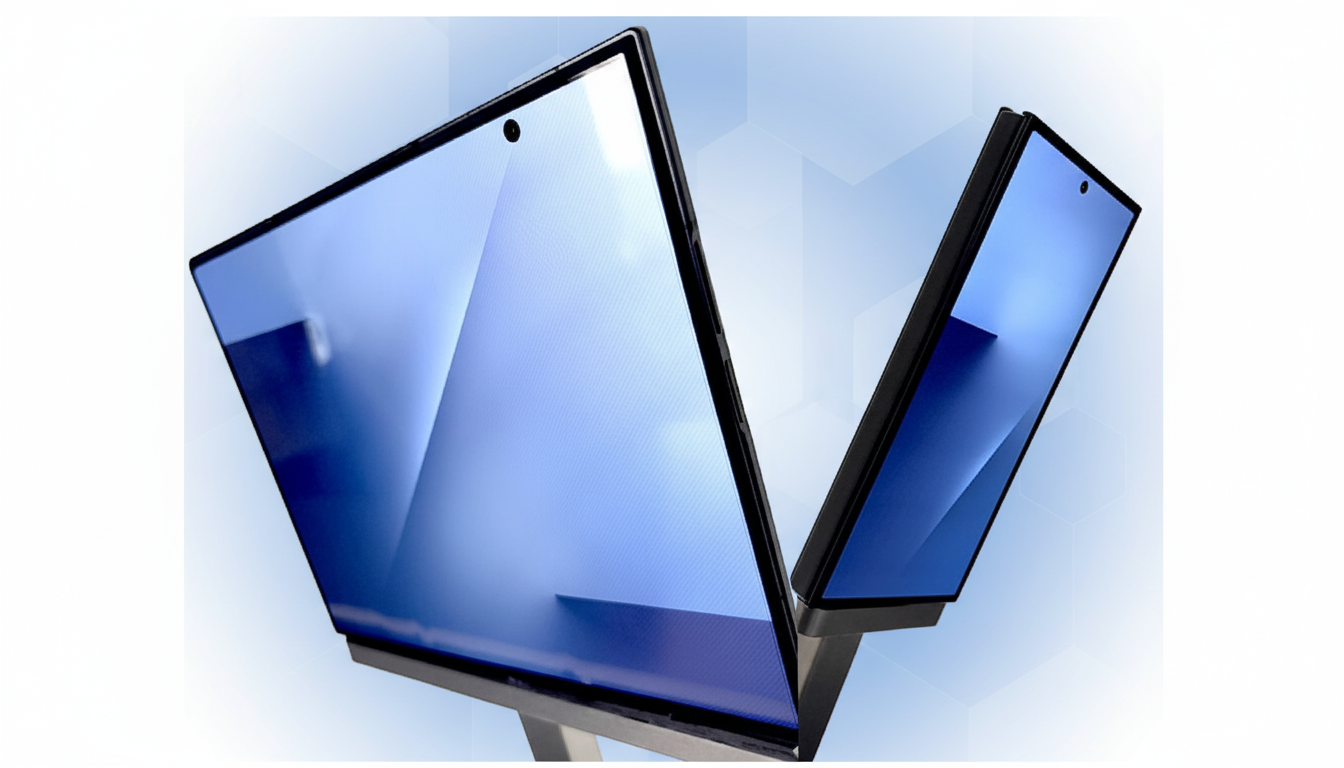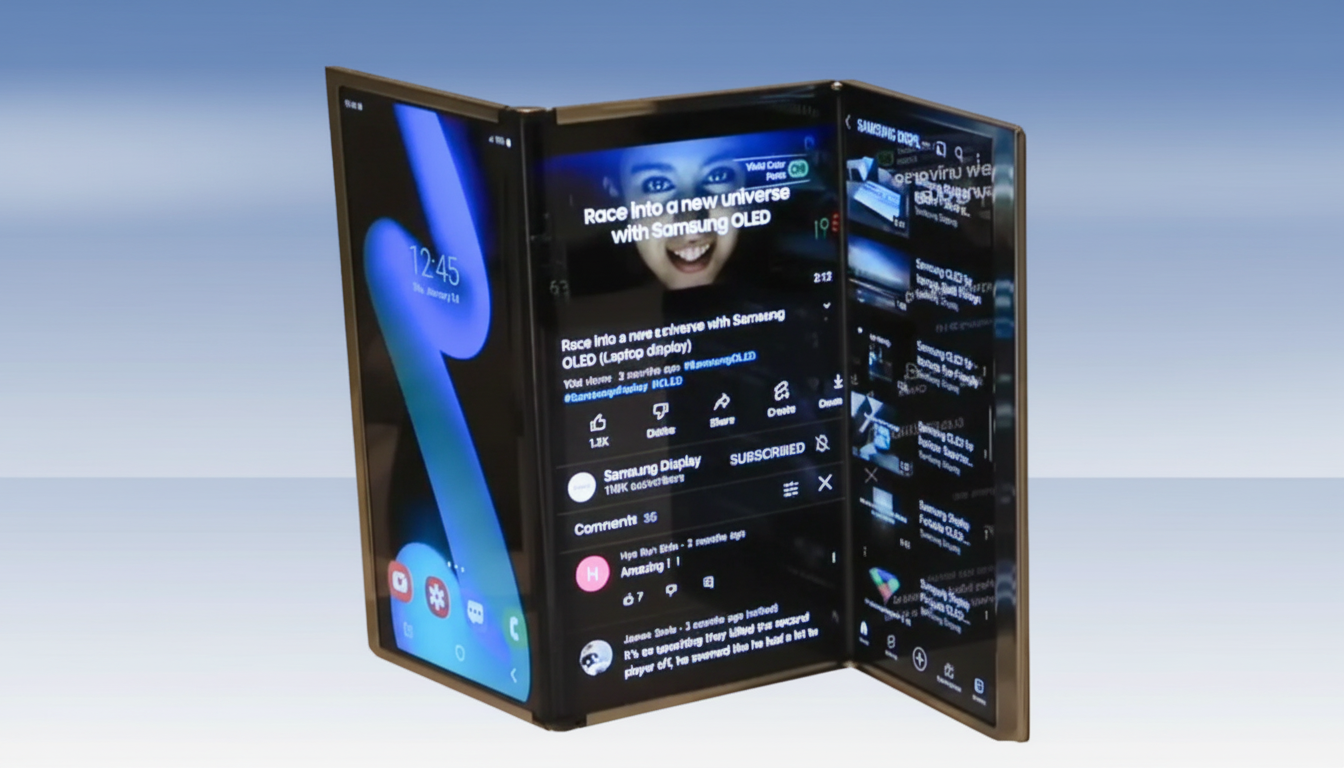Samsung quietly revealed at a Korean industry gathering their first trifold Galaxy Z concept, which unfolds a device twice to expose a tablet canvas of 10 inches and closes into a phone with a display of about 6.5 inches. Using an overlay to animate, the prototype remained behind a protective display to demonstrate folding, but the salient aspect was loud and clear: the Galaxy with double hinges is getting closer to prime time.
Prototype showcased behind glass at K-Tech in Korea
At the K-Tech show in South Korea, participants saw two units – one folded and one completely open – while video superimposed on the external display cycled through use modes. Notably, as is always the situation with cased prototypes, it was impossible to see the crease; however, that is not necessarily an indication of panel quality. Korean press Dailian reported that the extended internal display measured 10 inches diagonally, with main and external display cameras. Samsung did not provide specs or timelines, but publicizing hardware is a typical end-stage signal.
- Prototype showcased behind glass at K-Tech in Korea
- Double-hinge design promises new multitasking options
- Engineering hurdles span hinges, IP rating, and durability
- Software and S Pen support could define user appeal
- Market context and competition for foldables
- What to watch next for Samsung’s trifold concept

Double-hinge design promises new multitasking options
A double-hinge design could finally push foldables beyond single-fold phones if it can turn a pocketable handset into a near-tablet without taking on the actual compactness of two devices. It also provides a fresh software canvas: one panel for a video call, the other for taking notes, the third to consult reference sources—true three-up multitasking on a phone. Huawei and TCL have demonstrated these trifold notions before, and panel manufacturers such as BOE and Samsung Display have openly displayed multi-fold OLEDs, but a retail-ready product from a brand-name would signal a true market shift.
Engineering hurdles span hinges, IP rating, and durability
Two hinges double the mechanical complexity. Teardrop-style hinges are currently used in the best single-fold designs to reduce stress on Ultra Thin Glass, reduce crease severity, and accept a gapless close. The battery architecture—likely broken into three areas—, thermal management for flagship chipsets, and durability. Furthermore, one of the most prominent issues is ingress protection. Dust is the moving component’s enemy, and while water resistance has improved on conventional folds, certifying a double-hinge phone to competitive IP ratings might require more engineering. If this prototype truly reduces visible creasing, it demonstrates that there has been progress in OLED stack design, UTG thickness, and hinge pressure distribution.
Software and S Pen support could define user appeal
Android has matured for large screens, and Samsung’s One UI already supports taskbars, app continuity, and multi-window. A trifold ups the ante: seamless transitions between three form factors, consistent aspect ratios across panels, and intelligent app tri-layouts. Expect enhancements to broaden to pop-up windows, drag-and-drop, and continuity from external screen to full 10-inch mode, along with deeper tie-ins to Samsung’s ecosystem features like DeX and Multi Control. Pen input is another open question. A 10-inch panel is an invitation for sketching and productivity, but S Pen compatibility requires tougher glass stacks and digitizer integration. If supported, it would position the trifold as a true tablet replacement for note-takers and creatives.

Market context and competition for foldables
Foldables are still a small but growing slice of smartphones. IDC estimates global foldable shipments reached roughly 16 million in 2023, growing double digits year over year; Counterpoint Research has noted rising competition from Chinese brands, a trend that has pressured Samsung’s share even as the category expands. DSCC projects continued growth into 2025 as costs decline and panel yields improve.
Against that backdrop, a polished trifold could give Samsung a fresh lead. It likely slots above the Galaxy Z Fold series on price, reflecting its increased bill of materials—extra hinge, larger OLED area, and more complex mechanicals. Weight will matter too: today’s large foldables already push 240 grams; a trifold must balance battery life with comfort in hand and pocket.
What to watch next for Samsung’s trifold concept
Key signals to look for include hardware validation, durability targets, and software readiness for true three-panel workflows.
Key signals to watch
- Confirmation of panel specs, dimensions, and aspect ratios
- Hinge cycle ratings and broader durability metrics
- IP certification targets for dust and water resistance
- S Pen support details and digitizer integration
- Software demos of three-app multitasking without stutter
- Camera system specifics, including sensor size and optical zoom
Samsung has already shown its next-gen XR ambitions, and this trifold tease suggests its foldable roadmap is accelerating. If the company can offer a lighter-than-expected chassis, a quiet crease, and fluid app continuity in all modes, the first mainstream tri-fold might finally shift foldables from interesting to default choice for power users.

